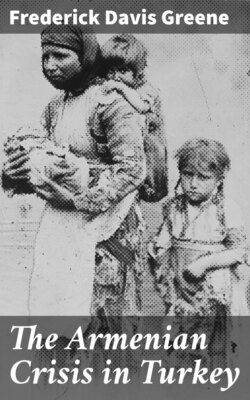Читать книгу The Armenian Crisis in Turkey - Frederick Davis Greene - Страница 7
На сайте Литреса книга снята с продажи.
EXPLANATORY NOTE BY THE AUTHOR.
ОглавлениеTable of Contents
These letters are written by men who can have no possible motive for misrepresenting the facts in the case, while, on the other hand, each writer subjected himself to personal danger by putting such statements upon paper and sending them through the mails. Several of the documents have gotten through Turkey by circuitous routes, in some instances having been sent by special messenger to Persia, and so on to this country. Others were never risked in the Turkish mails, but have come through the British post-office at Constantinople.
It must be borne in mind that no writer was an eye-witness of the actual massacre; nor could he have been, inasmuch as the whole region was surrounded by a military cordon during the massacre and for months after. The letters are largely based on the testimony of refugees from that region, or of Kurds and soldiers who participated in the butchery, and who had no hesitation in speaking about the affair in public or private until long after, when the prospect of a European investigation sealed their lips. Much of the evidence is, therefore, essentially first hand, having been obtained from eye-witnesses, by parties in the vicinity at the time, who are impartial, thoroughly experienced in sifting Oriental testimony, familiar with the Turkish and Armenian languages, and of the highest veracity. No one letter would have much force if taken alone, for it might be a large report of a small matter; but these sixteen letters are written independently of one another, at different times, and from seven different cities widely apart, five of them forming a circle around the scene of destruction. The evidence is cumulative and overwhelming.
There is absolute unanimity to this extent: that a gigantic and indescribably horrible massacre of Armenian men, women, and children did actually take place in the Sassoun and neighboring regions about Sept. 1, 1894, and that, too, at the hands of Kurdish troops armed by the Sultan of Turkey, as well as of regular soldiers sent under orders from the same source. What those orders were will probably never transpire. That they were executed under the personal direction of high Turkish military officers is clear. There can also be no doubt—for the official notice from the palace was printed in the Constantinople papers in November last—that Zekki Pasha, Commander of the Fourth Army Corps, who led the regular troops in the work of extermination, has since been specially honored by a decoration from the Sultan, who was also pleased to send silk banners to the four leading Kurdish chiefs, by a special messenger.
The latest, most accurate, and comprehensive document in this correspondence is No. 6, which is based on evidence obtained with special care at the nearest attainable point to the scene, and was prepared by parties in intimate relations with the European official who made the first investigation on the ground last October, but whose report has not yet been made public.
The letters are arranged in chronological order. In view of the fact that the names of the cities from which the various documents are dated must be withheld at present, these places are designated by letters of the alphabet. The separate extracts are also numbered to facilitate reference. In order that there may be no confusion, all explanatory comments of the author are enclosed in brackets.
